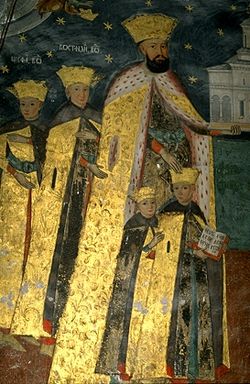Constantin Brancoveanu
| Constantin Brâncoveanu | |
|---|---|
| Prince of Wallachia | |
 |
|
| Reign | 1688–1714 |
| Predecessor | Șerban Cantacuzino |
| Successor | Ștefan Cantacuzino |
| Born | 1654 Brâncoveni, Wallachia |
| Died | 1714 Constantinople, Ottoman Empire |
| Spouse | Doamna Marica Brâncoveanu |
| Issue | Stanca (1676) Maria (1678) Ilinca (1682) Constantin (1683) Ștefan (1685) Safta (1686) Radu (1690) Ancuța (1691) Bălaşa (1693) Smaranda (1696) Matei (1698) |
| Saints Constantin, Constantin, Ștefan, Radu and Matei Brâncoveanu | |
|---|---|
 |
|
| Born | 1654 (Constantin) 1683 (Constantin) 1685 (Ștefan) 1690 (Radu) 1698 (Matei) Brâncoveni, Wallachia |
| Died | 15 August 1714 Constantinople, Ottoman Empire |
| Venerated in | Romanian Orthodox Church |
| Canonized | 20 June 1992, Bucharest |
| Major shrine | Relics at the New Church of St. George, Bucharest. |
| Feast | 16 August (Eastern Orthodox Church) |
| Attributes | They are usually depicted together, wearing golden cloaks. |
| Brâncoveni Monastery | |
|---|---|
 |
|
| Basic information | |
| Location | Brâncoveni, Olt County, Romania |
| Affiliation | Eastern Orthodox |
| Ecclesiastical or organizational status | Monastery |
| Status | active |
| Website | [2] |
| Architectural description | |
| Architect(s) | Patroness Celea (1570–83) Matei Basarab and Preda Brâncoveanu (1634–40) Constantin and Ștefan Brâncoveanu (1699–1704) Theodosius of Trebizond (1842) |
| Architectural type | Church |
| Architectural style | Brâncovenesc |
| Groundbreaking | 1570 |
| Completed | 1842 |
| Direction of façade | West |
Constantin Brâncoveanu (Romanian pronunciation: [konstanˈtin brɨŋkoˈve̯anu]; 1654 – August 15, 1714) was Prince of Wallachia between 1688 and 1714.
A descendant of the Craiovești boyar family and related to Matei Basarab, Brâncoveanu was born at the estate of Brâncoveni and raised in the house of his uncle, stolnic Constantin Cantacuzino. He soon became involved in the conflict between Constantin and Şerban Cantacuzino, and rose to the throne after the latter died in mysterious circumstances. He was initially supported by Constantin Cantacuzino, but the two ended up facing each other in a violent competition. Cantacuzino was exiled, and began advocating his son's Ștefan's candidacy to the throne, while competing with Brâncoveanu for the support of the Ottoman Empire - Wallachia's overlord.
The circumstances and facts of Constantin's death are history, his santification recognized in all The Eastern Orthodox Church.
Dragoș Ungureanu, a specialist at the National Patrimony Institute, makes "a clear distinction between the holiness status of Prince Brâncoveanu and the same quality of some European monarchs who haven’t suffered a martyr's death. Brâncoveanu was canonized for his and his sons' martyrdom, just like the Christians martyrdom in ancient Rome, killed for their faith in Christ. And just like other Christian martyrs, Brâncoveanu had to choose between his and his sons' death and the denial of Christ, (in their case, by converting to Islam). His character, the nature of his relations with the others, the unexpected events of life brought, against his will, in this strange, even shocking situation for the year 1714."
On 15 August 1714, Saint Mary Feast, when Constantin Brâncoveanu also celebrated his 60th birthday he and his four sons among with counselor Ianache were brought in front of Sultan Ahmed The Third of Turkey. Diplomatical representatives of Austria, Russia, France and England were also present. Here is what history remembers: After all of his fortunes were taken, in change of the life of his family he was asked to renounce at the orthodox-christian fate. He reportedly said: ″Behold, all my fortunes and all I had, I have lost! Let us not lose our souls. Be brave and manly, my beloved! Ignore death. Look at Christ, our Savior, how much has endured for us and with what shamefull death has died. Strongly believe in this and do not move, nor do you leave your faith for this life and this world.″ After this, his four sons, Constantin, Ștefan, Radu and Mathew and counselor Ianache were beheaded in front of their father.
...
Wikipedia
